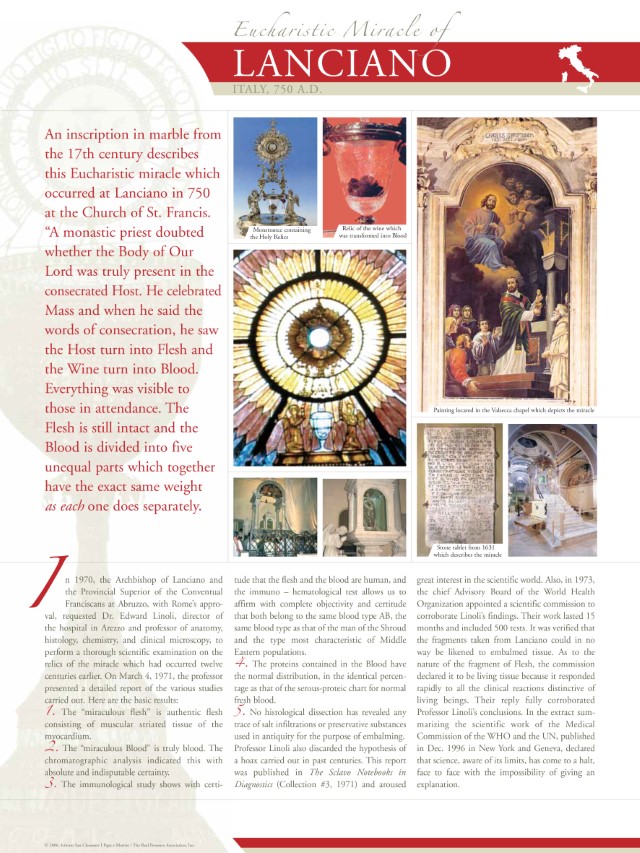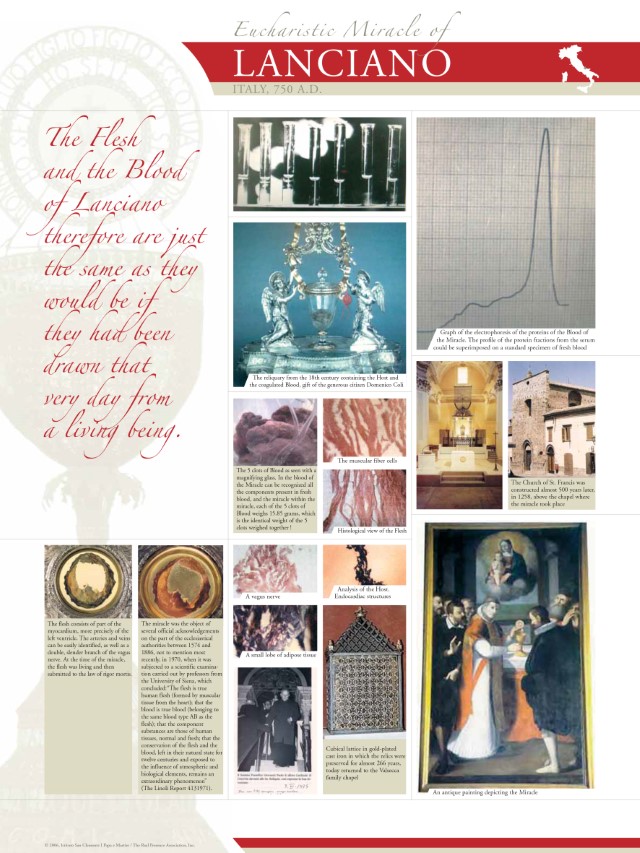This is my Body
Eucharistic
Miracles
This is my Blood
What is a Miracle of the Eucharist?
Miracles of the Eucharist are miraculous divine interventions that are aimed at confirming faith in the real presence of the body and blood of the Lord in the Eucharist. We are familiar with the Catholic doctrine relating to this real presence; with the Words of Consecration, “this is my body” and “this is my blood,” the substance of the bread becomes the body of Christ and the substance of the wine becomes his blood. This awe-inspiring change is known as transubstantiation, in other words, the transition of the substance. Only the appearances, or species, of the bread and wine remain; these are known by the philosophical term “accidents”. The dimensions, colour, flavour and odour remain, as do the nutrients, but the substance, or rather the true reality, does not remain because it has become the body and blood of Christ. Transubstantiation can in no way be experienced by the senses; faith alone makes certain of this miraculous change.

Eucharistic Miracles around the World
Miracles of the Eucharist tended to confirm this faith, which is based on are in the words of Christ, according to which what seems like bread is no longer bread, and what seems like wine is no longer wine. Flesh and blood, or one or the other, appear in Miracles of the Eucharist, depending on the case. The aim of miracles such as these is to demonstrate that we should not look at external appearances (bread and wine), but at the substance, at the true reality of things, which is flesh and blood.
Medieval theologians scrutinised the issue of Miracles of the Eucharist (which were very common at that time), and interpreted them in a variety of different ways. The most well founded and reasoned of these seems to be that of the supreme “Doctor of the Eucharist” Saint Thomas Aquinas (cf. Summa Theologica III, q. 76, a. 8). He says that the body and blood that appear after the miracle are a result of the transformation of the Eucharistic species, or rather of the accidents, and that they do not affect the real substance of the body and blood of Christ. The species of the bread and wine are miraculously changed into species of flesh and blood, but the real body and real blood of Christ are not those that appear. They are those that, even before the miracle, were hidden beneath the species of the bread and wine, and continue to exist hidden beneath the species of the flesh and blood. If, in fact, the flesh and blood that appear were really the flesh and blood of Christ, we would have to say that the risen Christ, who reigns at God’s right hand, loses a part of his flesh and blood. We must therefore say that the flesh and blood that appear in the miracles are a type of species, appearance or accident, no more and no less than the species of the bread and wine. The Lord carries out these miracles to give a sign that is easy and visible to all, that the real body and blood of Christ are present in the Eucharist. But this real body and this real blood are not those that appear, rather they are substantially contained beneath the species or appearances, species or appearances that were those of the bread and wine before the miracle, and after the miracle are those of flesh and blood. Christ is truly and substantially contained beneath the appearances of flesh and blood, just as he was before the miracle. This is why we can worship Christ in his real presence beneath the species of the flesh and blood.
Father Roberto Coggi O
http://www.miracolieucaristici.org/en/liste/scheda.html?nat=pannelli&wh=pannellob&ct=Panel%20B
Please click on the button to read the story.
The Eucharistic Miracle of Lanciano, Italy
An inscription in marble from the 17th century describes this Eucharistic miracle which occurred at Lanciano in 750 at the Church of St. Francis.
“A monastic priest doubted whether the Body of Our Lord was truly present in the consecrated Host. He celebrated Mass and when he said the words of consecration, he saw the Host turn into Flesh and the Wine turn into Blood. Everything was visible to those in attendance. The Flesh is still intact and the Blood is divided into five unequal parts which together have the exact same weight as each one does separately.”
The Flesh and the Blood of Lanciano therefore are just the same as they would be if they had been drawn that very day from a living being.
The Story of the Eucharistic Miracle of Lanciano
Please click on the image to read.
Eucharistic Miracles and the Miracle of Lanciano
The Eucharistic Miracle of Buenos Aires, Argentina
The parish of Saint Mary in Buenos Aires has been the protagonist of 3 Eucharistic Miracles that occurred in 1992, 1994 and 1996.
In 1992, after the Mass of Friday May 1, while preparing the Eucharistic reserve, a Eucharistic minister found some pieces of consecrated Host on the corporal. Following what the Church prescribes to do in these situations, the priest had them put in a vessel of water, which was then placed in the tabernacle to wait for them to dissolve. In the following days, several priests went to check it and they realized that nothing had changed. Seven days later, on Friday, May 8, they opened the tabernacle and saw that the Host fragments had become a reddish color that looked like blood. The following Sunday, May 10, during the two evening Masses, several small drops of blood were noticed on the patens with which the priests distributed Communion.
On Sunday, July 24, 1994, during the children’s Mass, while the Eucharistic minister took the pix from the tabernacle, he saw a drop of blood running along its side.
On August 15, 1996, during the Mass of the Assumption of the Most Holy Virgin, a consecrated Host, which fell to the ground during the distribution of Communion, had to be placed again in a vessel of water so it would dissolve. A few days later, on August 26, a Eucharistic minister opened the tabernacle and saw that Host had transformed into Blood.
The Story of the Eucharistic Miracle of Buenos Aires
Please click Presentation Mode button to view in full screen.
The Eucharistic Miracle of Santarem, Portugal
According to the date recorded in the document commissioned by King Alfonso IV in 1346, on February 16, 1266, in Santarem, a young woman overcome with jealousy for her husband, consulted a sorceress who told her to go the church and steal a consecrated Host to use for a love potion.
The woman stole the Host and hid it in a linen cloth that immediately became stained with Blood. Frightened by this, she ran home and opened the kerchief to see what had happened.
To her amazement, she saw that the Blood was gushing from the Host. The confused woman stored the Particle in a drawer in her bedroom.
That night the drawer began to emit brilliant rays of light which illuminated the room as if it were daytime. The husband, also aware of the strange phenomenon questioned his wife, who was obligated to tell him everything.
The next day, the couple informed the pastor, who went to the home to remove the Host and return it to the church of St. Stephen in solemn procession, accompanied by many religious and lay people. The Host bled for three consecutive days.
Every year, since the miracle occurred, on the second Sunday of April, the precious relic is processed from the home of the couple to the Church of St. Stephen. The couple’s home became a chapel in the year 1684.
The Story of the Eucharistic Miracle of Santarem
Please click Presentation Mode button to view in full screen.
Eucharistic Miracle of Legnica, Poland
In St. Hyacinth’s church in Legnica, during Holy Mass, on December 25, 2013, a Host accidently fell on the ground, during the distribution of Communion. It was immediately placed in a container with water and closed in the tabernacle.
St. Hyacinth’s priest, Father Andrzej Aiombra, said that on January 4th, along with other priests, he went to see if the consecrated Host had dissolved in the water after nearly two weeks: “Immediately we noticed that the Host had not dissolved, and that a red spot covering a fifth of its surface appeared. We decided to inform the Bishop, who established a special theological scientific commission to analyze the event. We noticed that over time the stain on the Host changed color from deep red to red brown (…)”.
The sample was taken directly by the scientists on 26 January 2014. For the priests the miracle was evident. The commission checked if it was some fungus, mold or another external agent (…). The Wroclaw Forensic Medicine Institute immediately excluded the presence of bacteria or fungi as a cause for the Host turning red. A second histopathological analysis pointed out that some fragments seemed to belong to myocardial tissue.
An additional opinion was sought using the same samples at the Institute of Forensic Medicine in Szczecin without specifying where the samples came from. The Institute used a different analysis method.
After the analysis, The Pomeranian Medical University’s Department of Histopathology in Szcecin announced that “tissue fragments containing fragmented parts of cross-striated muscle” was found in the histopathological image. This is similar to “human heart muscle with alternations that often appear during the agony. We have not tested the blood found on the Host, we only know that human DNA was found.”
The results of the analysis were presented to the Vatican’s Congregation for the Doctrine of the Faith, which recognized the supernatural nature of the event.
It is striking that the examination results were similar to those of the Lanciano Eucharistic Miracle of 700 A.D. and other Miracles that occurred recently such as Sokolka in 2008, in Poland, Tixtla in 2006 in Mexico, and Buenos Aires, in Argentina in 1996.
On April 17, 2016, following the instructions received by the Holy See. Monsignor Zhigniew Kiemikowskiego, the new Bishop of Legnica, announced during Mass that the parish priest Fr. Andrezj Ziombra should “prepare a suitable place for the exhibition of the precious relic, so that the faithful can express their adoration properly”.
The Story of the Eucharistic Miracle Legnica, Poland
Please click Presentation Mode button to view in full screen.



